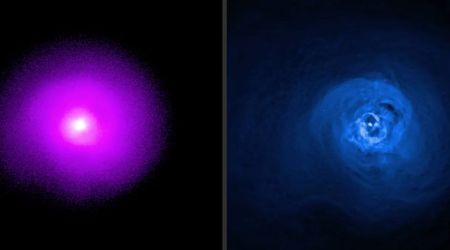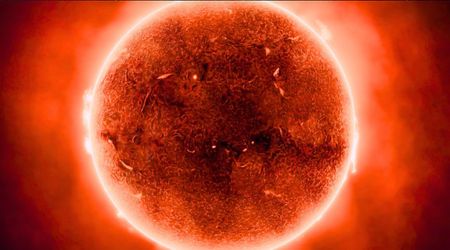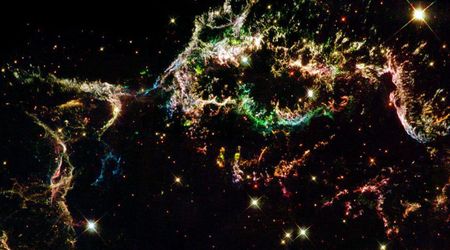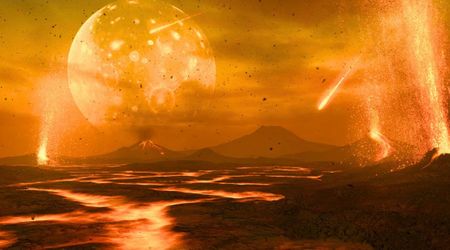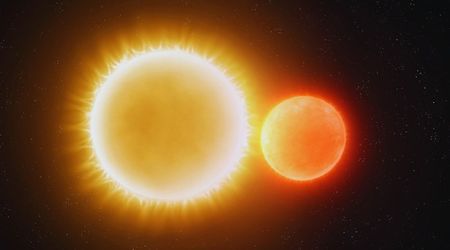Hubble reveals a dwarf galaxy erupting with star formation in the Hunting Dogs constellation

The NASA/ESA Hubble Space Telescope continues to provide invaluable insights into the dynamic processes shaping galaxies across the cosmos, with recent observations highlighting both prolific star formation and subdued galactic environments in our cosmic neighborhood. One fascinating subject, the dwarf galaxy NGC 4449, located a mere 12.5 million light-years away in the constellation Canes Venatici, stands out as a "starburst galaxy," according to NASA.
Seeing stars with NGC 4449! 💫
— HUBBLE (@HUBBLE_space) June 20, 2025
Access more space-themed .gifs at our giphy page: https://t.co/9KQS4UMAAF pic.twitter.com/GRtIzl4VGH
Despite its smaller size compared to the Milky Way, NGC 4449 is a hub of intense star-forming activity. Uniquely, this stellar birth is not confined to its core but is occurring throughout the galaxy, a phenomenon scientists attribute to gravitational interaction with nearby galactic systems. Its close proximity makes NGC 4449 an exceptional laboratory for studying how such interactions influence the creation of new stars.
This is the nearby dwarf galaxy NGC 4449, which is punching above its weight when it comes to star formation! It is forming new stars much faster than expected for its size, making it a starburst galaxy 🌟 1/3 pic.twitter.com/zrsLXETaAY
— HUBBLE (@HUBBLE_space) June 19, 2025
The latest Hubble imagery of NGC 4449 integrates data from various observing programs, offering a comprehensive view of its star formation history and mapping its brightest and most massive stars. Further enhancing this understanding, the NASA/ESA/CSA James Webb Space Telescope has also observed NGC 4449, providing detailed views of its dusty gas tendrils illuminated by the light of its burgeoning young stars.
Our ESA/Hubble Picture of the Week features a small but mighty galaxy! 1/5 pic.twitter.com/QEmFu1g9Xv
— HUBBLE (@HUBBLE_space) June 16, 2025
In stark contrast to NGC 4449's energetic display, Hubble has also captured the more tranquil galaxy NGC 4242, situated approximately 30 million light-years away, also within Canes Venatici. This galaxy, first discovered by William Herschel in 1788 and visible even with basic telescopes, presents a different galactic narrative. Studies indicate that NGC 4242 exhibits a moderate-to-low surface brightness and luminosity, coupled with a comparatively low rate of star formation. Its visual characteristics include a bright central region surrounded by a dimmer, more diffuse halo, along with a faint and poorly defined spiral structure and a weak bar of stars traversing its asymmetric core. These contrasting observations by Hubble underscore the vast diversity of galactic evolution and activity within the relatively nearby universe, per NASA.
Adding to these diverse galactic portraits, astronomers have released a remarkable new image of the Sculptor Galaxy, also known as NGC 253, revealing intricate galactic systems in stunning detail. This groundbreaking image, depicting the galaxy in thousands of colors, was captured using the Multi Unit Spectroscopic Explorer (MUSE) instrument at the Very Large Telescope (VLT) in Chile.

Located approximately 11 million light years away, the Sculptor Galaxy is now visible with an unparalleled level of complexity. This extensive image, covering 65,000 light-years of the galaxy's 90,000-light-year span, required a significant undertaking: 100 exposures collected over 50 hours of MUSE observing time. This considerable effort was justified by the unparalleled detail unveiled, which is expected to provide critical insights into the poorly understood complexities of galactic systems.

Enrico Congiu, team leader of the Universidad de Chile, highlighted the galaxy's ideal position for study, stating, "It is close enough that we can resolve its internal structure and study its building blocks with incredible detail, but at the same time, big enough that we can still see it as a whole system." Kathryn Kreckel, a team member from Heidelberg University in Germany, further emphasized the image's versatility, noting, "We can zoom in to study individual regions where stars form at nearly the scale of individual stars, but we can also zoom out to study the galaxy as a whole." These new observations promise to significantly advance our understanding of how galaxies like the Sculptor Galaxy function and evolve.
